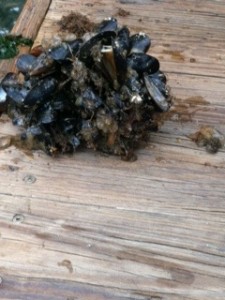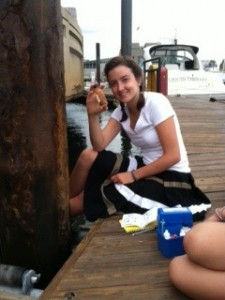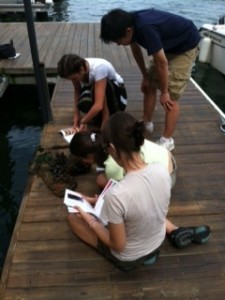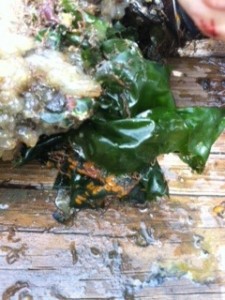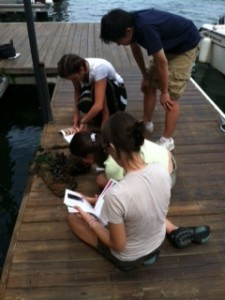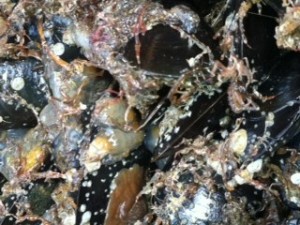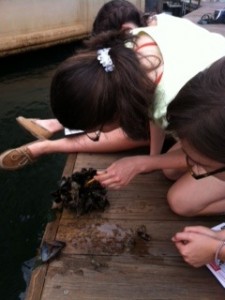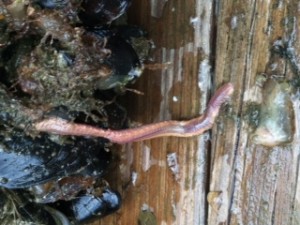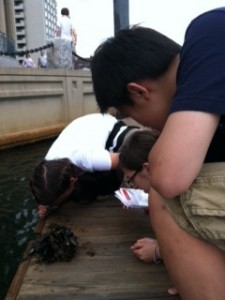On the third, we were given an excellent opportunity to visit the MIT AUV Lab – conveniently located in the same building as the Sea Grant program. After a quick elevator ride and a jaunt down the hall way, we arrived in what appeared to be a small museum. Decommissioned AUVs hung from the ceiling or sat with wires exposed.
There we met Mike Soroka, who, while taking generous gulps of iced coffee, proceeded to take us through the history of MIT’s AUVs.
But what is an AUV? The acronym AUV stands for Autonomous Underwater Vehicle, used by marine scientists to go where they cannot. Not to be confused with ROVs (which require a driver/operator), AUVs can be given specific tasks to complete without super vision.
The first vehicle we saw (and on of the first made in the MIT AUV lab) was the original Odyssey, made to go under Antarctic ice. This was something no ROV was able to do, since they required cable tethers and had short range. But the Odyssey had one sixth the weight and twice the range of all other vehicles and was able to go under the ice successfully in January 1993.
As AUVs became more sophisticated, more problems had to be addressed. Turning, maintaining depth and position, resistance to pressure in deep ocean scenarios, etc. The AUV lab managed to come up with an elegant solution to the problem of maintain depth and position. Instead of having a torpedo like fixed thruster at the back, the Odyssey IV has four in different locations. Two are fixed, cross-body thrusters which allow the Odyssey to move sideways without turning or moving vertically. The other two bisect the body and are able to rotate – giving the AUV four degrees of freedom and the ability to “hover” in the water.
Unfortunately, even with a high tech computer that measures exactly where each thruster is on its rotation, accidents can happen. Some times one thruster can get a little faster than another, which causes the AUV to “freak out”, as Mike put it, and pin itself to the ocean floor.
A good example of the autonomy and precision of AUVs would be the AUV Odyssey IV ‘s pipe inspection. People in charge of oil rigs normally warn marine scientists to stay away from rigs because all the drilling and welding noise messes up the machines acustic instruments. These instruments are vital for navigation, since GPS doesn’t work under water. However, the Odyssey IV is different – it has a camera it can use for navigation. To convince the oil workers that was safe for the AUV to be there, the AUV Lab guys commanded the Odyssey to find the pipe, maintain a specific depth and distance away and drive three circles around it -only using its camera to navigate. The Odyssey IV performed it flawlessly and convinced the people in charge. Here is the demo video. A bad example would be crashing. Unfortunately the Odyssey IV we saw was decommissioned after a boat landed on it while trying to pick it up with an on-board crane.
Mike Soroka also showed us the new AUVs they are working on: new, more specialized incarnations of the REX II reef explorer. The REX II itself is pretty cool. They managed to fix the problem of navigation by just attaching a giant buoy to the top that houses a GPS navigation system. Here are some highlights from some of it’s missions.
Further into the future, AUVs could navigate their own boat deployment systems, untie themselves from docks and go on missions -all by themselves.
The AUV lab was a truly excellent way to take a break from our mini research projects.
-Carolann

